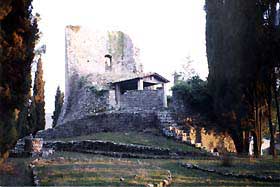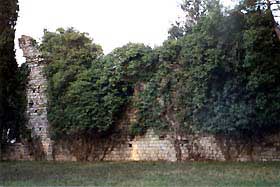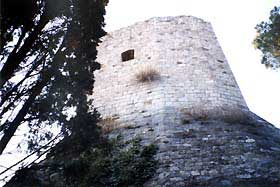Castiglione del Bosco Castle
|
 |
| The strongly bastioned external front of the Keep. | The rests of the Keep viewed from the inner ward. |
Castiglione del Bosco, now an agricultural farm, can be reached today from the SS2 Cassia, just passed Buonconvento following the indications for Bibbiano and then those for Castiglione. The last line of the road is not asphalted but under good conditions.
Castiglione del Bosco, known in the Middle Age as 'Castiglione on the Ombrone', was a small important fortress due to its strategic position between the towns Montalcino and Buonconvento.
 |
| A surviving part of the external enclosure walls. |
Its importance is also recognized in a document of the 1208 in which were fixed the taxes to pay at the Republic Senese for all the suburbs of the zone: Castiglione paid more than all the others. The original fortification seems to go back to the first years of the 1200, when the family Cacciaconti of Trequanda surrounded the hill with stone walls. Subsequently the possession passed to the family of the Gallerani and in 1339 to the Piccolomini, that conquered the castle after a long and bloody siege. In this period the fortification has been strengthened, mainly with the reconstruction of the mighty bastionated keep. After a few years was set the last word to the history of Castiglione del Bosco: on June 13th 1369 the Senese army, in hunting of the exiled families of the Scotti and Marescotti, conquered and leveled to the ground the castle.
Today the ruins of the castle rises in the garden of a private villa, built enclosing the north-east angle of the external castle walls. The fortification, crowning the vertex of a hill of 350 meters high, had the form of the classic medieval castle-fenced. Today still remain some lines of the walled enclosure, a gate and the partially destroyed keep. Its form is similar to those of the not far Rocca of Tentennano and the worked stones used in its construction still testimony the ancient importance of this settlement.
| Back to Homepage |
| Back to Castles Index |
